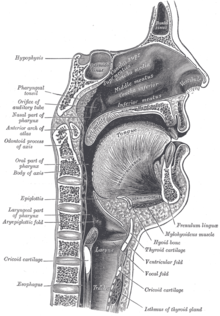| Part of a series on |
| Reading |
|---|
 |
Subvocalization, or silent speech, is the internal speech typically made when reading; it provides the sound of the word as it is read.[1][2] This is a natural process when reading, and it helps the mind to access meanings to comprehend and remember what is read, potentially reducing cognitive load.[3]
This inner speech is characterized by minuscule movements in the larynx and other muscles involved in the articulation of speech. Most of these movements are undetectable (without the aid of machines) by the person who is reading.[3] It is one of the components of Alan Baddeley and Graham Hitch's phonological loop proposal which accounts for the storage of these types of information into short-term memory.[4]

- ^ Carver, R. P. (1990) Reading Rate: A Comprehensive Review of Research and Theory (1990)
- ^ Cleland, D. L., Davies, W. C and T. C. 1963. Research in Reading. The Reading Teacher, 16(4), 224-228
- ^ a b Rayner, Keith and Pollatsek, Alexander (1994) The Psychology of Reading
- ^ Smith, J. D., Wilson, M., & Reisberg, D. (1995). The role of subvocalization in auditory imagery. Neuropsychologia, 33(11), 1433-1454.